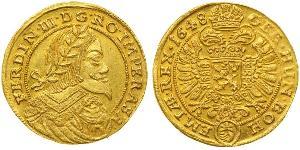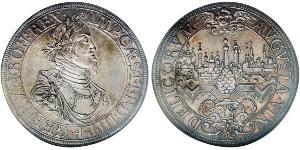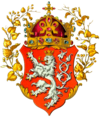| This article needs additional citations for verification. (February 2011) |
Ferdinand III (13 July 1608 – 2 April 1657) was Holy Roman Emperor from 15 February 1637 until his death, as well as King of Hungary and Croatia, King of Bohemia and Archduke of Austria.
Contents
Life[edit]
Ferdinand was born in Graz, the eldest son of Emperor Ferdinand II of Habsburg and his first wife, Maria Anna of Bavaria. Educated by the Jesuits, he became King of Hungary in 1625, King of Bohemia in 1627 and Archduke of Austria in 1621.
In 1627 Ferdinand enhanced his authority and set an important legal and military precedent by issuing a Revised Land Ordinance that deprived the Bohemian estates of their right to raise soldiers, reserving this power solely for the monarch.[2]
Following the death of Wallenstein (who had previously denied him the overall military command of the Catholic side) in 1634, he was made titular head of the Imperial Army in the Thirty Years' War, and later that year joined with his cousin, the Cardinal-Infante Ferdinand, being nominally responsible of the capture of Donauwörth and Regensburg, and of defeat of the Swedes at the Battle of Nördlingen. Leader of the peace party at court, he helped negotiate the Peace of Prague with the Protestant states, especially Saxony in 1635.
Having been elected King of the Romans in 1636, he succeeded his father as Holy Roman Emperor in 1637. He hoped to be able to make peace soon with France and Sweden, but the war dragged on for another 11 years, finally coming to an end with the Peace of Westphalia (Treaty of Münster with France, Treaty of Osnabrück with Sweden) in 1648, both negotiated by his envoy Maximilian von und zu Trauttmansdorff, a diplomat who had been made a count in 1623 by his father Ferdinand II.
During the last period of the war, in 1644 Ferdinand III gave to all rulers of German states the right to conduct their own foreign policy (ius belli ac pacis). This way the emperor was trying to gain more allies in the negotiations with France and Sweden. This very edict contributed to the gradual erosion of the imperial authority in the Holy Roman Empire.
After 1648 the emperor was engaged in carrying out the terms of the treaty and ridding Germany of the foreign soldiery. In 1656 he sent an army into Italy to assist Spain in her struggle with France, and he had just concluded an alliance with Poland to check the aggressions of Charles X of Sweden when he died on 2 April 1657.
Marriages and children[edit]
On 20 February 1631 Ferdinand III married his first wife Archduchess Maria Anna of Spain (1606–1646). She was the youngest daughter of Philip III of Spain and Margaret of Austria. They were first cousins as Maria Anna's mother was a sister of Ferdinand's father. They were parents to six children:
- Ferdinand IV, King of the Romans (8 September 1633 – 9 July 1654)
- Maria Anna "Mariana", Archduchess of Austria (22 December 1634 – 16 May 1696). Married her maternal uncle Philip IV of Spain.
- Philip August, Archduke of Austria (15 July 1637 – 22 June 1639)
- Maximilian Thomas, Archduke of Austria (21 December 1638 – 29 June 1639)
- Leopold I, Holy Roman Emperor (9 June 1640 – 5 May 1705)
- Maria, Archduchess of Austria (13 May 1646)
In 1648, Ferdinand III married his second wife, Archduchess Maria Leopoldine of Austria (1632–1649). She was a daughter of Leopold V, Archduke of Austria, and Claudia de' Medici. They were first cousins as male-line grandchildren of Charles II, Archduke of Austria, and Maria Anna of Bavaria. They had a single son:
- Karl Josef, Archduke of Austria (7 August 1649 – 27 January 1664). He was Grand Master of the Teutonic Knights from 1662 to his death.
In 1651, Ferdinand III married Eleonora Gonzaga (1630–1686). She was a daughter of Charles IV Gonzaga, Duke of Rethel. They were parents to four children:
- Theresia Maria Josefa, Archduchess of Austria (27 March 1652 – 26 July 1653)
- Eleonora Maria of Austria (21 May 1653 – 17 December 1697), who married first Michael Korybut Wiśniowiecki, King of Poland, and then Charles Léopold, Duke of Lorraine.
- Maria Anna Josepha of Austria (30 December 1654 – 4 April 1689), who married Johann Wilhelm, Elector Palatine.
- Ferdinand Josef Alois, Archduke of Austria (11 February 1657 – 16 June 1658)
Music[edit]
Ferdinand III was a well-known patron of music and a composer. He studied music under Giovanni Valentini, who bequeathed his musical works to him, and had close ties with Johann Jakob Froberger, one of the most important keyboard composers of the 17th century. Froberger lamented the emperor's death and dedicated to him one of his most celebrated works, Lamentation faite sur la mort très douloureuse de Sa Majesté Impériale, Ferdinand le troisième; a tombeau for Ferdinand III's death was composed by the renowned violinist Johann Heinrich Schmelzer. Some of Ferdinand's own compositions survive in manuscripts: masses, motets, hymns and other sacred music, as well as a few secular pieces. His Drama musicum was praised by Athanasius Kircher, and the extant works, although clearly influenced by Valentini, show a composer with an individual style and a solid technique.[3]
Recordings of Ferdinand's compositions include:
- Jesu Redemptor Omnium. Deus Tuorum. Humanae Salutis. With Schmelzer: Lamento Sopra La Morte de Ferdinand III. Joseph I: Regina Coeli. Leopold I: Sonata Piena; Laudate Pueri. Wiener Akademie, dir. Martin Haselböck, CPO 1997.
- Ferdinand III: Hymnus "Jesu Corona Virginum". On Musik für Gamben-Consort. Klaus Mertens, Hamburger Ratsmusik, dir. Simone Eckert CPO 2010
Ancestors[edit]
| This section does not cite any references or sources. (September 2014) |
Titles[edit]
Ferdinand III, by the grace of God elected Holy Roman Emperor, forever August, King of Germany, King of Hungary, Bohemia, Dalmatia, Croatia, Slavonia, Rama, Serbia, Galicia, Lodomeria, Cumania and Bulgaria, Archduke of Austria, Duke of Burgundy, Brabant, Styria, Carinthia, Carniola, Margrave of Moravia, Duke of Luxemburg, of the Higher and Lower Silesia, of Württemberg and Teck, Prince of Swabia, Count of Habsburg, Tyrol, Kyburg and Goritia, Marquess of the Holy Roman Empire, Burgovia, the Higher and Lower Lusace, Lord of the Marquisate of Slavonia, of Port Naon and Salines, etc. etc.
See also[edit]
- Kings of Germany family tree. He was related to every other king of Germany.
Notes[edit]
- ^ Hengerer, Mark (2012). Kaiser Ferdinand III. (1608-1657): Eine Biographie (in German). Wien - Köln - Weimer: Böhlau Verlag. p. 62. ISBN 978-3-205-77765-6.
- ^ Rothenburg, G. The Army of Francis Joseph. West Lafayette: Purdue University Press, 1976. p 3.
- ^ Lederer, Josef-Horst. "Ferdinand III". In Macy, Laura. Grove Music Online. Oxford Music Online. Oxford University Press. (subscription required)
References[edit]
- Lothar Höbelt, Ferdinand III. (1608–1657). Friedenskaiser wider Willen (Graz: Ares Verlag. 2008), 488 S.
External links[edit]
 Media related to Ferdinand III, Holy Roman Emperor at Wikimedia Commons
Media related to Ferdinand III, Holy Roman Emperor at Wikimedia Commons
|
Ferdinand III, Holy Roman Emperor
Born: 13 July 1608 Died: 2 April 1657 |
||
| Regnal titles | ||
|---|---|---|
| Preceded by Ferdinand II |
King of Hungary and Croatia 1627–1657 with Ferdinand II (1625–1637) Ferdinand IV (1647–1654) |
Succeeded by Leopold I |
| King of Bohemia 1627–1657 with Ferdinand II (1627–1637) Ferdinand IV (1646–1654) |
||
| Holy Roman Emperor Archduke of Austria 1637–1657 |
||
| King in Germany 1636–1653 with Ferdinand II (1636–1637) Ferdinand IV (1653–1654) |
||
| Preceded by Elizabeth Lucretia |
Duchy of Teschen 1653–1657 with Ferdinand IV (1653–1654) |
|
|
|||||||||||||||||
|
|||||||||||||||||||||||||||||||||||||||||||||||||||||||||||||
|
||||||||||||||||||||||||||||||||||||||||
|
||||||||||||||||||||||||||||||||||||||||||||||||||||||||||||||||||||||||||||||||||
|
||||||||||||||||||||||||||||||||||||||||||||||||||||||||||||||||||||
|
||||||||||||||||||||||||||||||||||||||||||||||||||||||||||||||||||||||||||||||||||||||||
|
||||||||||||||||||
|
- 1608 births
- 1657 deaths
- Habsburg kings of Bohemia
- Rulers of Transylvania
- Bohemian princes
- Dukes of Carinthia
- Dukes of Teschen
- German kings
- Holy Roman Emperors
- House of Habsburg
- Kings of Hungary
- Hungarian princes
- Knights of the Golden Fleece
- People from Graz
- Rulers of Austria
- Rulers of Styria
- 17th-century Austrian people
- Kings of Croatia
- Baroque composers

















